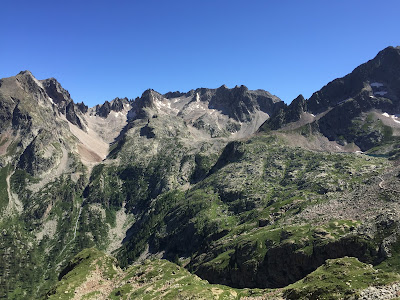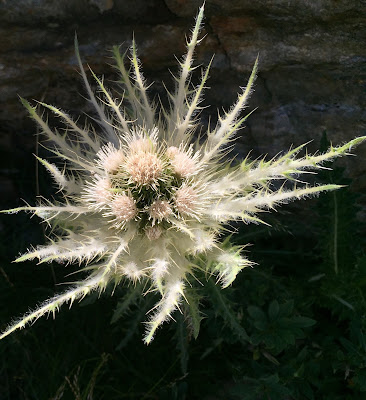Photos of Via Pignolo, Bergamo. Center: Fontana del delfino with Palazzo Lupi.

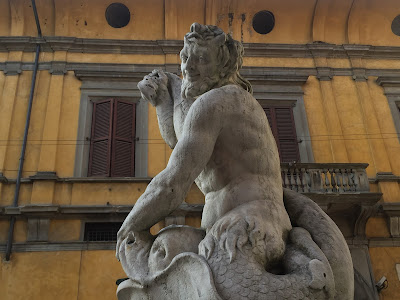
 Perché Bergamo
Perché Bergamo? Why Bergamo? That's the question most people ask when they find out we've chosen to live in Bergamo. They seem incredulous that anyone would choose to live here. But, that's exactly what we have done and in this post we'll explain why we've chosen Bergamo for our sabbatical, and what we think about our choice.
+
Overview
+
Planning
+
Reality
+
Smiley for Bergamo
+
Borgo Living
+
Will I Meet a Tourist?
+
Addendums
Overview
In the summer of 2015, the start of our second sabbatical was looming a few months in the future and we still hadn't locked down where we wanted to land in Italy. Heck, we didn't know if we would even stay long in one place, but we knew that we needed somewhere to start.
We spent our first sabbatical in 2007/2008 in Florence. For our second sabbatical, we knew that we should not attempt to repeat the first sabbatical's magic in Florence. Furthermore, we were planning to stay longer this time, and we needed to consider factors like long term cost, education options, and ability to get to nature quickly, specifically access to mountains, which is important to us. So we studied the problem and like good engineers created maps, spreadsheets, and documents exploring the options. In the end, we chose Bergamo.
If you are interested in the factors we used to choose Bergamo, see the next section,
Planning, else skip to
Reality for what we think today about our choice. For more about our thoughts on taking a sabbatical, see
Sabbatical Lessons: Thoughts and Stories from our Italian Sabbaticals.
Planning
Factors that were important to us for choosing a city in Italy for our sabbatical included:
- Education options
- We had a strong recommendation from a friend and former Italian teacher that the University of Bergamo's CIS - Italian for Foreigners program was very good. And, in fact, that has proven to be the case. We just completed a semester there at language level B2 and were very happy.
- Location
- Bergamo is close to the mountains. From the city you can access the mountains on foot, car, bus, or tram. All the goodness that comes from mountainous geography is something we really wanted as part of our stay. Bergamo is squashed up against the mountains with the Po River Plain (Pianura Padana) to the south at its feet and the Bergamasque Alps and Prealps to the north at its back. In fact, our planning map (see image below) reveals that all of our candidates for cities were located near mountains; many of the cities we considered were on the edge of the Po River Plain.
- Size
- Bergamo was in our Goldilocks zone of not being too small or too big, coming in at about 120,000 people. We were looking for cities in a range of 50,000 to 300,000. We felt that we could get a more realistic and authentic experience living in a city of moderate size, with some economic foundation other than tourism. See Will I Meet a Tourist? for an attempt at measuring how "touristy" Bergamo is. Our sense is that it isn't (yet) overrun with tourists.
- Museums and gardens
- We like museums and gardens and we wouldn't pick a city that didn't have them. Bergamo has small number of good museums including the Accademia Carrara, Gamec, and the 8 museums that are part of the Fondazione Bergamo nella storia. You can easily return to them every few months and not be bored. More museums can be easily reached by train in Milan, Brescia, and Verona, for example. In addition, there is one botanical garden in Bergamo, but for us, the parks and nearby green of the mountains are as interesting, if not more.
- Trains
- Rail stations are classified in terms of the services they offer and how many passengers they serve, which is directly related to how well connected they are. A higher rating for us would be better since we wouldn't have a car. Bergamo is rated as gold out of bronze, silver, gold, platinum (the best).
- Osterie d'Italia
- We use the Slow Food Osterie d'Italia guide for finding places to eat and have had good results. We trust the guide and were curious how many Osterie d'Italia entries were in or close by the cities we were considering. For us, it is an indication of how interesting the culinary scene is. (We gathered the counts from the Osterie d'Italia IOS App.) Unfortunately, Bergamo didn't do so well in this category with just one entry (Al GiGianca - we tried it, very nice). I'll hold my observations on the Bergamasco culinary scene for another time. Suffice it to say, we enjoy our jaunts outside Bergamo.
Left: Map of Italian cities we considered for our second sabbatical. Center: Neighborhoods of Bergamo (source). Right: Example of spreadsheet used to select a sabbatical city.



Here are some factors we considered but didn't influence our decision very much or at all:
- Climate
- We knew we didn't want long, cold winters or long, hot summers. Given that, most of the cities we were considering approximately fit the bill and it was hard to distinguish between them in terms of climate. Bergamo is listed as a humid subtropical climate, which sounds okay, but what does it really mean to live in that climate coming from Seattle? We just didn't know. Also, given the climate variations we've seen of late, what would Bergamo really experience in weather?
- Diversity
- We looked at the percentage of immigrants and the existence of an Arcigay chapter as two measures of diversity, but really didn't understand what, if anything, we could infer. An interesting tidbit of information is that the diocese of Bergamo has strong ties with Roman Catholic Archdiocese of Cochabamba in Bolivia which has translated into the biggest immigrant population in Bergamo originating from Bolivia. See page 220 of Statistiche demografiche 2016. Unfortunately, we have yet to stumble across an interesting Bolivian restaurant in Bergamo.
- Health
- We looked at the number of gyms and yoga studios for a sense of how active cities are. It's hard to readily get such a list, so we searched using maps and key words for an approximate count. In the end we didn't put much weight on what we found, because the physical activity of a city is obviously more than just these two factors. From our on-the-ground experience, we find Bergamo to be a pretty health-conscious city. There are lots of runners and walkers we see daily in the streets, as well as other indications the Bergamaschi care about their health.
- Income
- We looked at median income of cities we were considering. Bergamo comes in at the top in this respect. And, at least according to this 2011 article, Bergamo was the second richest city in Italy. In the end, the median income didn't have much influence on our decision.
- Final rating
- We never came up with a final ranking, that is, weighting and adding all the factors together for a final score. The act of just creating the spreadsheet and talking about the factors that were important to us, was enough to make the decision.
Some aspects of a place are hard to appreciate until you are actually living there, experiencing it firsthand. Here are a few things we missed in our analysis:
- Trains
- While Bergamo is rated as gold (pretty good), it is not on one of the Italian high-velocity train routes. Judging by the griping we hear (especially when we take our shirts to the cleaners where we always get an earful) and our experience, Bergamo got the short end of the stick in terms of train routes. The fastest train routes run through Treviglio to the south leaving Bergamo as a sort of spur. What this means practically, is that in order to catch a fast train to another city you first have to take a train to Milan or Brescia, an extra 45 minutes. Honestly though, it hasn't impacted us that much.
- Airport
- We underestimated how useful the Orio al Serio Airport could be, in particular, with Ryanair cheap flights. We have made good use of it so far, travelling between Bergamo and Madrid, Lisbon, Berlin, Pescara, and Bari. We hope to make more use of it in upcoming trips, and find ourselves plan trips around Ryanair routes. Getting to Milan Linate, or the Milan Malpensa airport from Bergamo is a hassle, making Orio al Serio a blessing.
- Church
- We are told that the church exercises a great deal of control and owns a lot of property in Bergamo. This means that no nightclubs are located within city limits because the church doesn't want them, which means kids have to go great distances to party in a disco thereby causing great inconveniences for the kids and their parents that shuttle them back and forth. For us, it hasn't been a big deal. Interestingly, the city sponsors a wealth of dance, music, and general events across the city that are full of young and old.
- Also, the city's main and oldest daily paper, L'Eco di Bergamo, is owned by the diocese of Bergamo, and says next to nothing interesting or controversial.
- WIFI
- Libraries
- There are decentralized libraries (outside the city center at Betty Ambiveri, Caversazzi, Colognola, Gavazzeni, Loreto, Pelandi, Valtesse) and centralized libraries (Biblioteca Civica Antonio Tiraboschi, Biblioteca Civica Angelo Mai, Biblioteca Accademia Carrara e Gamec, Biblioteca Museo di Science Caffi, Biblioteca ISREC). For more information, see Biblioteche della città di Bergamo. Your best bet is Tiraboschi or Angelo Mai. We prefer the majestic Angelo Mai in Città Alta. Also, Bergamo WIFI is accessible from inside the library.
- As well, there are the libraries of the University of Bergamo, the most convenient being the Biblioteca di Economia e Giurisprudenza or the Biblioteca umanistica. For more information, see UniBG Biblioteche and portale for hours and holiday closures. These libraries can be used by the general public.
We used the
Comuni-Italiani.it site to gather some statistics for our decision-making. Here are the numbers for
Bergamo. Also, the Bergamo
comune site has detailed stats (
Bergamo in cifre); most
comuni have some stats if you poke around.
Passages of Bergamo, always beckoning you to explore.




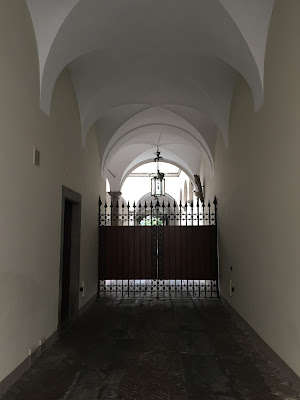
Reality
Overall, we feel like we made a good choice with Bergamo. I'm sure there are a half dozen other Italian cities that would have worked, or rather I should say, we would have made work for us. I'm not sure how much we should credit our planning and how much luck. So back to the original question:
perché Bergamo? The simple answer comes down to education opportunities, geography and proximity to mountains, and an good experience in a mid-sized Italian city. We just completed a semester in the University of Bergamo's
CIS - Italian for Foreigners program at language level B2 and were very happy with the quality of the instruction and what we learned. Furthermore, we had an opportunity to get out and explore the area with a number of hikes and long walks (see
bergamo + hiking) around Bergamo. As for an good experience in a mid-sized Italian city, only time will tell, but so far we are loving it.
Usually after giving our answer to "
perché Bergamo", the conversation turns to what we think about the people of Bergamo. And here, we surprisingly find that
Bergamaschi assess themselves as being hard (
duro), unfriendly, and only concerned about money. What's interesting, is that we've found the complete opposite to be true. In fact, we've developed more close and meaningful relationships here than we did in Florence. It could be that we are different now. Or, it could be that Florence suffers more tourist pressure (see
Will I Meet a Tourist?) and making friends with people living there is more difficult. At any rate, we include among our friends here in Bergamo, people born and raised in and around Bergamo, Italians from other parts of Italy, and other expats. So dear
Bergamaschi: sorry your cover is blown…when we smile and start talking, you immediately melt and become friendly.
We've found such unexpected hospitality here, like from the owners of
La Rosa Scarlatta, our home for the first few weeks after arriving last November. Their help proved to be key to finding the right apartment for us, for which we are eternally grateful. Also, unexpected are the cast of characters (dare we include ourselves?) who frequent
Caffè Papavero in Piazzetta del delfino and the cafe's exuberant and welcoming owner. You just never know who you might find there or what activity you might get asked to join.
For all our vacations in Italy over 20+ years (at least 10) and our sabbatical in 2007-2008, we never stayed in Italy in the summer. So here we are in July and we are experiencing our first Italian summer. There are a few things that we notice in particular. First, the fragrance of
tilia (
tiglio in Italian) trees. We never have experienced the tilia trees like we have this spring and summer. At night, when we walk the Venetian walls of the Città Alta after dinner, a honey-like perfume engulfs us. It's intoxicating. Besides the tilia trees, the common swift (
Apus apus) are a new wondrous sound. The high-pitched calls of these birds blend together into a pleasant background noise common in Bergamo, as well as elsewhere in Europe in the summer months. Out past stays in Italy were either after swifts has already left (late summer) or hadn't arrived yet (late spring) as they are migratory birds. Finally, in the summer, Italians take to the streets in the evenings like we've never seen before. Cities like Bergamo come alive each night with different activities. In Bergamo, among the many activities going on is the
Borgo Sant'Agostino, an outdoor eatery and gathering point in Città Alta. (Other data points: recently, we spent a week enjoying the nightly shows of
Cuneo Illuminata in Piedmont; and, we spent 5 nights in Lecce, Puglia where it seemed normal to eat no earlier than 10 pm and then shop the street markets until midnight.)
We griped a bit in the beginning of our stay about the fact that Bergamo doesn't have a central market like you might find in Florence (Son Lorenzo, Central, Sant'Ambrogio, and Santo Spirito). Over time, we found it works a little different here with once a week markets in different parts of the city. For example, you can find markets at:
- Piazzale della Malpensata (Monday morning, big, food and lots of low quality items)
- Piazzetta Santo Spirito (Tuesday morning, small, charming)
- Piazza Pontida (Friday morning, small, charming)
- Piazza Mascheroni Lorenzo, Città Alta (Friday morning, medium)
- Piazzale Goisis Lodovico, Atalanta Stadium (Saturday morning, medium, quality items)
A list is
here, but it's not complete. We've seen other markets here and there. For example, there is a seller of food from Piemonte who appears the third Sunday in the month near Largo Gianadrea Gavazzeni (behind Teatro Gaeteano Donizetti). And, there is always something going on the Sentierone. In fact, you are guaranteed to find one or more stall, if not dozens, lining the Sentierone on any given week. We've seen stalls selling confetti for Mardi Gras, candy of every sort, cheese, clothes, huge loaves of Pan Pugliese, foods from other regions of Italy, and chocolate. The stalls are usually aligned with a themed exhibition, like chocolate, sustainable energy, or a book fair, or, they are aligned with a holiday.
For everyday needs, we go to a
fruttivendolo - a small, local grocer focusing on mostly fruits and vegetables, fresh and typically local. Our current favorites are
Mora Roberto (friendly and full of advice) and
Bresciani Livio (great selection if not a bit expensive).
Random images from around Bergamo, Italy.




Smiley for Bergamo
The Jane Smiley story about
bliss in Bergamo found its way to us from friends concerned we might be missing out on something. Even the echoey L'Eco di Bergamo picked up on it:
La nostra città sul New York Times. I'm guessing the Smiley piece helped Bergamo cheer up after feeling a tad bit neglected with all the fuss about Christo's
Floating Piers project and all the attention it brought to the Lago Iseo communities. (We went to the
Floating Piers, and it was awesome.)
I'm happy that Pulitzer Prize winning Smiley had a good time in Bergamo, and a just little miffed because I selfishly don't want more tourism here due to her blissful reporting. She is right about the gardens and the green in Bergamo, and the beauty of the hills where she stayed. However, the thing that struck me in her piece was that in 6 months living here we have never once gone to
Il Pianone, the restaurant that was the center of her blissdom (located in the Valverde area). In fact, I had to look it up to see where it was. Most of the people we know in Bergamo have never been there or dismiss it as a venue for weddings and events.
One recent, hot Saturday night, we set out to find Il Pianone. After leaving the Città Alta and a little past the Orto Botanico Garden on Via Beltrami, we start hearing "You're the One That I Want" (Grease soundtrack) blaring from somewhere in the green hills. We soon reach
Trattoria Parietti, a humble restaurant that we like, and continue to reach Il Pianone. By now, the music has changed to "My Sharona" (The Knack). We can see that a wedding reception is in progress on the terrace, probably American judging by the music. Il Pianone's commanding view and sweeping terrace make it an obvious choice for such events. We are satisfied we found it, but promptly turn around to head back down to Città Alta. Just before we were out of earshot of the reception, the music changes again to "Karma Chameleon" (Culture Club). We head for
Borgo Sant'Agostino to eat in the park and listen to
CarmenSita.
Another thing that struck me in the NYT article was Smiley's "faded and tragic" impression of San Pellegrino. Yes, there are a lot of those impressions to be had in Italy. In fact, Smiley need only have dropped down into the Città Bassa to take a look at the empty military barracks (
caserma) in my neighborhood. The barracks was once the beautiful and noble
Palazzo Lupi. After the start of Italy's military drawn down in the late 1990's and the suspension of mandatory service in 2004, barracks all over Italy were not needed. Palazzo Lupi stands vacant with weeds growing out the roof. We can lean out our window and see it's mustard colored façade and shuttered windows. It seems faded and tragic, but it will live again. That's Italy. It's hubris that we judge things by our limited concept of time.
Left: Biblioteca Civica Angelo Mai. Center: A palazzo entrance on via Pignolo. Right: Light fixture under the portici near Balzer Pasticceria.
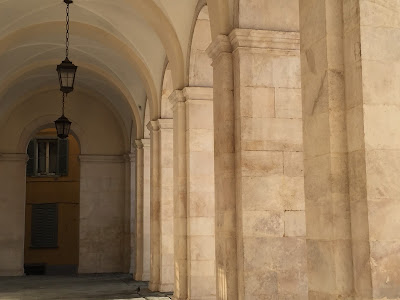

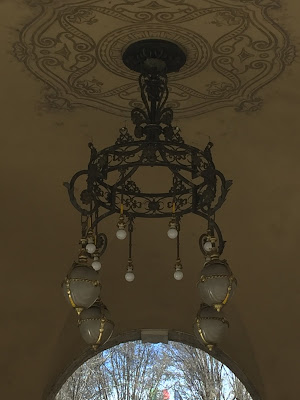
Borgo Living
Smiley's article also made me think about how you choose to see and experience a city depends on a myriad of decisions you make including where you choose to base yourself. For a vacation of a week or two, you might choose a hotel in the hills around Bergamo, but for our longer stay we needed to consider cost and the practicality of everyday living, while still maintaining some charm and authenticity - a decision different for each person.
I remember arriving in Bergamo on a cool and foggy November night in 2015, days after the Paris attacks. We walked through deserted streets alternately thinking about the violence of the previous days and noting locations of stores and services that we might need in the coming days, trying to strike a balance between past and future, despair and hope. We walked past a memorial to the victims outside the city hall (
municipio) and then up to the Porto Giacomo lit up in the colors of the French flag.
The next day, the clouds and fog continued the somber mood as we struck out on foot to see Bergamo for the first time in the light. We evaluated the parts of the city we saw not in terms of a tourist but in terms of a resident. We were interested how we could we live without a car, what transportation options we could use, and where we would do our shopping, the locations of the
fruttivendolo,
macelleria, and
famacia - the stuff of every day living.
In addition to lots of exploring on foot, we used
immboliare.it to understand neighborhoods and what types of apartments were available. After a few weeks of searching for an apartment, we learned a few things. The first was that living in Città Alta was not a pratical choice for us, nor was living in the outlying areas like Valverde, Colli, or Valtesse. It's not that we wouldn't have like to, but the cost of these highly "prized" areas and access to services without a car wasn't practical. The second thing we learned was that using
immboliare.it, calling and meeting real estate agents, was not turning up good fits for us. Yes, the real estate agents found places to live that were okay for cost and practicality, but suffered on charm in a big way. For example, one apartment we looked at was close to the train station, in a modern building, with a neighborhood we couldn't identify with and plain just didn't like. Another option was a beautiful apartment in a shabby building surrounded by other taller buildings; the apartment's views was out on the front door of the local Jehovah's Witnesses office. Nope, not that one. I don't care if it's really nice inside and actually has a dryer (a rarity).
So we were caught in the catch-22 of finding a place to stay that was livable, practical and kind to the wallet while giving us what we needed in terms of historical authenticity and charm. After a few weeks of what seemed like fruitless searching, we discovered that Bergamo has interesting, centrally located
historic neighborhods (
borghi) like Borgo Pignolo (an old and important route between Città Alta and Venice), Borgo San Leonardo (connecting Città Alta with Milan), Borgo Santa Caterina, and Borgo Canale. These
borghi provide the convenience of being close to (and really part of) the lower city while maintaining historic and authentic appeal. So we concentrated our efforts in these neighborhoods as a place to live.
The third thing that we learned while searching for an apartment was that we needed to build relationships. Yeah, big head slap, right? We tried the clinical (geek way) of filling out a form on a website and waiting for something perfect and orderly to happen. Even using immobiliare.it, we really needed to get on the phone and talk to get any traction and start a relationship with the agents so they knew who we were and what we were looking for. The key we were missing for the first several weeks was building relationships. In the end, we found an apartment in Borgo Pignolo through friends. When we met the owner, we hit it off and built a relationship. The take-away advice if you find yourself in a similar situation is to make friends, ask around, and let people know what you are looking for.
Borgo Pignolo where we live - more precisely upper Pignolo around Piazzetta del delfino - is close to Città Alta while being technically located in Città Bassa (or centro). It's a beautiful and historic area, like Piazza Pontida, Via Sant'Alessandro, Borgo San Caterina and Borgo Palazzo to name just a few others. These examples fly in the face of the over-exagerated conception of the Città Bassa as a uniformly ugly place. It is true that the lower city has more modern parts than Città Alta, and there are some ugly, severe-looking structures. However, you could also leverage a sort of reverse criticism at Città Alta in that it's more stage set for tourists than livable for the average person.
A few months after settling into Borgo Pignolo, we went to Vicenza, the stomping grounds of the famous architect
Palladio. We stayed the night there, and the hotel clerk after finding out we were from Bergamo exclaimed: "Città Bassa is so ugly." We were a bit crushed, and tried to explain there are other areas of Città Bassa that are very nice. I knew then we were starting to settle in and that we were proud of our new city because we felt like we needed to defend it.
Photos of buildings in Bergamo. Left: Liceo Classico Statale Paolo Sarpi. Center: Palazzo on Via Pignolo. Right: Palazzo on Piazza Giacomo Carrara.



Will I Meet a Tourist?
From the source
Bergamo in Cifre 2014, we can make the following very rough calculation (using rounded figures):
- 240,000 total arrivals in 2013
- 240,000/365 = 660 tourists/day
- 120,000 people who live in Bergamo (1,100,00 in provence of Bergamo)
- 12,000 people you "might" encounter in your normal day (let's say 10% of 120,000)
- 660/12,000 x 100 = 5% of people you "might" encounter in a day would be tourists
Obviously, if you spend your day in Città Alta, the percentage of tourists you encounter will be higher, at least greater than 50%. If you spend your time in the Malpensata neighborhood (just south of center of Bergamo), you may not encounter any tourists. The percentage of tourists you encounter is also seasonal. More in summer, less in winter.
For comparison, Florence has millions of tourists arriving (3.8 million for 3/4 of the year according to this
source from the provincia
site) and about 380,000 people living in Florence. Let's round to 4 million tourist arrivals for a year (and this is still low), so that we can make a similar calculation as shown above:
[(4,000,000/365) / (380,000)(0.10)] * 100 = 29% (higher than the 5% calculated for Bergamo)
We used number of total arrivals (
arrivi) for the calculations here. You can also repeat them using the number
presenze (in the links cited above), which accounts for number of nights stayed by tourists. Regardless of what figure you use (
arrivi or
presenze), the interesting point is the magnitude of yearly tourists compared to number of people that live in the city, or tourists per inhabitant. For arrivals (
arrivi) in Bergamo, it's (240,000/120,000) or 2 tourists per year per inhabitant. For Florence, it's (4,000,000/380,000) or 10.
Left: A woman walks up Via Sant'Alessandro. Center: A cabbage on display in front of a fruttivendolo. Right: A flower seller in Piazzetta del delfino.


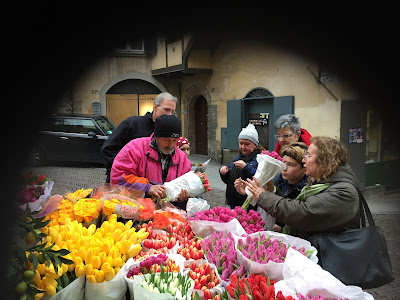 Left: Città Alta, Bergamo from the Camponone Torre Civica. Center: A slice of the Po River Valley and Sky from Città Alta. Right: Confetti after Mardi Gras on Il Sentierone.
Left: Città Alta, Bergamo from the Camponone Torre Civica. Center: A slice of the Po River Valley and Sky from Città Alta. Right: Confetti after Mardi Gras on Il Sentierone.
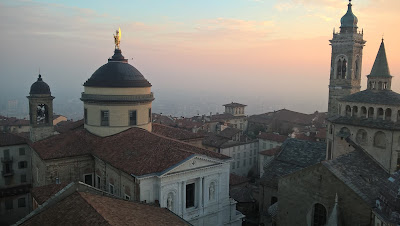


Addendum: November 2016
We just came across the ItaliaOggi-Università La Sapienza di Roma ranking of the cities of Italy. In the study, cities are ranked on 9 different factors:
affari e lavoro (business and labor),
ambiente (environment),
criminalità (criminality),
disagio sociale e personale (social and personal hardship),
popolazione (population),
servizi finanziari e scolastici (financial and educational services),
sistema salute (health system),
tempo libero (leisure time),
tenore di vita (standard of living). At this time, we could not find information to really dig into the details of each factor. You can start reading about the study in
La Repubblica or the
BergamoPost.
In the ranking, Bergamo was number 15 in 2015, but slipped to number 25 in 2016. Top of the list in 2016 is Mantova. Bottom of the list for 2016 is Crotone.
Addendum: June 2017
A check-in: we are still asked this question regularly, no change there. However, we've realized recently that title of this post is not quite right. In fact, many people will ask the question with the more common "come mai Bergamo", which translates to to something between "how come Bergamo" and "what brings you to Bergamo".
Addendum: June 2025




![[Asteraceae] Cirsium spinosissimum [Asteraceae] Cirsium spinosissimum](https://blogger.googleusercontent.com/img/b/R29vZ2xl/AVvXsEgzp1knOSuizu2dtBBJQzZ4oVGTJ5p5eeo4xC0o43Ic-AN2tZtdkNv6GwCufsvYBlA2ZukNAspQEz5kHcbQiUGMR08U2UrYXjS3tiiRqRE0rDKeNMyrF-evoqATO2zKOLIQk6-Ps5DELA/s400/Cirsium+spinosissimum.jpg)
![[Liliaceae] Paradisea liliastrum [Liliaceae] Paradisea liliastrum](https://blogger.googleusercontent.com/img/b/R29vZ2xl/AVvXsEjGV2gRIl5yiHZ6M6lndkt4a8zF_mDvxubxvbzwYBYUPJjTzaywK2jcWFqg1ZHm2kI3IToXt0Kok3-UDtNFYRnjr3xxGpKTVoTaMdrGr70YsJC5nKeljjofHCl9uIdZDS_DpfENu0gHPg/s400/Paradisea+liliastrum.jpg)
![[Ranunculaceae] Aquilegia alpina [Ranunculaceae] Aquilegia alpina](https://blogger.googleusercontent.com/img/b/R29vZ2xl/AVvXsEjdaBCPo13FW5XjgYxWEWsz-dgjDXREWtAmg703_6603M8gFSaNJgmr3C8ro1wuwirCl3u_bl0mYTWnPM7L2zR0qekLvr7diQa6Xx_WkdiPEmFGn3jnB7TvafVJwPKFscqSkiL6eBWI3A/s400/Aquilegia+alpina.jpg)






